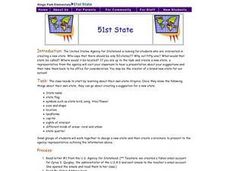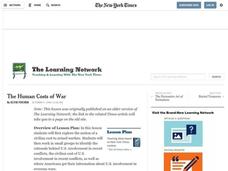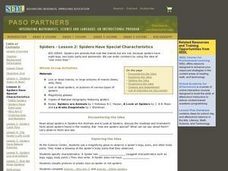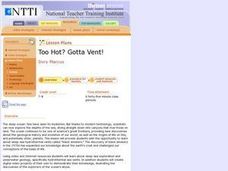Curated OER
"Five Little Seeds"
Fourth graders complete various activities related to the plant life cycle. They read the book "The Tiny Seed," read and discuss the poem "Five Little Seeds," complete a "Plantenstein Mystery" and other online activities, write and...
Curated OER
51st State
Students, in small groups, design a new state and create a brochure to present to an agency representative outlining the given information in the lesson. Students use templates in the compute lab to write sentences they have created...
Curated OER
Safari Sentence Scramble
Students use real life experiences for writing. In this identifying details lesson, students use information such as colors, numbers, sizes, shapes and locations to write sentences about the zoo. Students position the words from left...
Curated OER
Swat The Spot
Students practice beginning letter/sound association. In this beginning letter/sound lesson, students listen to a reading of Potluck by Anne Shelby while identifying the sounds that are associated with the beginning letters of words in...
Curated OER
Rosa Parks Changed the Rules
Students listen to a story about Rosa Parks and examine the bus seating rules of the 1950s. In this civil rights movement instructional activity, the teacher reads students a book about Rosa Parks, then students complete a worksheet...
Curated OER
People Change the Landscape
Learners examine ways in which humans have brought change to the natural environment. In this ecology and literacy activity, students listen to the book Island Boy by Barbara Cooney. Learners observe and define map-reading vocabulary as...
Curated OER
Similes
Second graders explore similes. In this figurative language lesson, 2nd graders read the book Quick As A Cricket and choose a simile to illustrate.
Curated OER
Anansi Goes To Lunch
Students read and explore a folktale from West Africa. In this folktale lesson, students read the book Anansi Goes to Lunch and discuss facts about spiders. Students sing the song "The Itsy Bitsy Spider" and complete several included...
Curated OER
Importance of the Rain Forest
Students use the Internet to conduct a research project. In this rain forest lesson plan, students work in groups to research different parts of the rain forest. Students research climate, foods, house products and medicines. Each...
Curated OER
The Human Costs of War
Learners explore the concept of civilian cost to armed warfare. They explore the role of the military, civilians and of press coverage during armed conflicts, creating posters illustrating their research on post-WW II military conflicts.
Curated OER
Spiders Have Special Characteristics
Students state reasons why spiders are grouped in specific categories, including what distinguishes a spider from an insect. They report on their observations of the spiders. They illustrate their report with drawings in their journals.
Curated OER
STEP INTO IT WITH GOLDILOCKS
First graders use sequencing to recall and tell the story of Goldilocks and the Three Bears. They create a storyboard using pencils first and then crayons with six illustrations in sequence.
Curated OER
Too Hot? Gotta Vent!
Students study deep sea exploration and underwater geology, specifically hydrothermal sea vents. They create digital video projects of their own to demonstrate their knowledge, illustrating the discoveries of the explorers of the ocean's...
Curated OER
Behind the Cover
Students develop questions they would have liked to ask an author about their written works. They read an article about their forefathers and research a back story to a written work of their choice. They create posters to illustrate the...
Curated OER
So You Think the World Evolves Around You?
Students examine the topic of evolution as it relates to biodiversity in various remote areas of the world. They watch videos, conduct Internet research, and in small groups create a digital video report to illustrate common evolution in...
Curated OER
Goop to geoforms
Learners illustrate geographical terms in three dimensional form. They use magic modeling goop and paint to create features of the geographic landscape. Students explain the meaning of geographical terms.
Curated OER
Making a Connection
Young scholars research why government community workers are important to us. They work in teams to identify and illustrate the jobs and services provided by these community workers. Assessment comes from their Student Concept Maps.
Curated OER
Exploring the Moon
First graders complete an experiment illustrating why the moon appears to change over time using a flashlight and ball. Students discuss the shape of the moon and identify it as a sphere. Students write a short informational piece after...
Curated OER
Mythical Beasts
Students explore literature and art forms containing creatures that are part human and part animal, such as the Greek Sphinx, Neptune, or the Green Centaur. Individually, students write a poem or short story to create a character with...
Curated OER
Shortest Distance Between Points and Lines
Learners use technology to determine the shortest between two points in a plane. They are required to support their analytic explanations with visual illustrations.
Curated OER
Jokes And Riddles
In this writing worksheet, students first select a collection of jokes and riddles to read. Students complete 4 activities: illustrating jokes, making a matching game with riddles and answers, making a comic strip, and telling a joke...
Curated OER
Frederick Lesson Plan
Students enjoy Leo Lionni's illustrations in Frederick and watching how Frederick uses his imagination. In this Frederick lesson plan, students practice dramatic techniques as they retell traditional literature.
Curated OER
Spring Lesson Unit on Peter Rabbit by Beatrix Potter
Students read about Peter Rabbit. In this lesson, about reading and comprehension, students listen to the story, The Tale of Peter Rabbit, by Beatrix Potter. Students answer questions about the story to determine comprehension. Students...
Curated OER
The Great Kapok Tree- Teaching About Conflict in Literature
Students identify the plot of a text. In this literature instructional activity, students listen to the book The Great Kapok Tree and identify the problem and solution. A graphic organizer is used to help reinforce the concept.

























